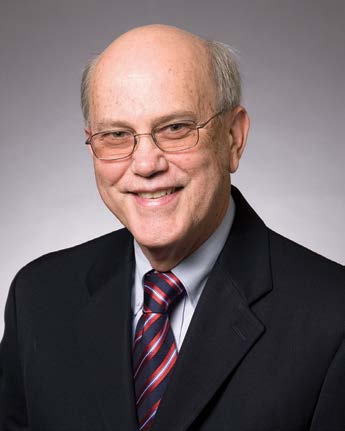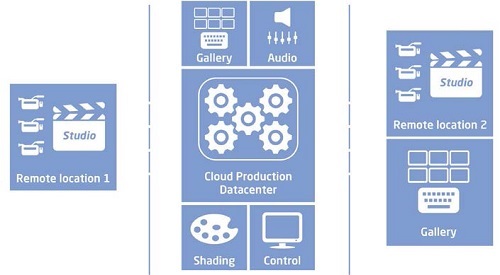NEP Steps Up Live IP Remote Production
PITTSBURGH and HILVERSUM, THE NETHERLANDS—Cloud and IP technologies are beginning to disrupt traditional live television production, and a groundbreaking example can now be found in the Netherlands. That’s where the NEP-owned DutchView and Infostrada Creative Technology companies are about to launch a new centralized cloud-based system for live production.
The operation, slated to go live this month, will use the companies’ fiber network to deliver IP video from cameras in sports venues and studios to a centralized data center. This data center, which holds most of the broadcast production equipment, is also linked via fiber to a gallery, or studio control room, and other rooms where the monitors and the director and other staffers might be located.
“It gives you the potential to put the cameras for an event in City A, have the central infrastructure for producing the event in City B and the control room in either the same building as the data center or somewhere else, in City C,” said George Hoover, chief technology officer of NEP, which is the largest provider of mobile production services in the U.S. and owns a number of production companies around the globe.

George Hoover This marks a major change from the way live events are typically produced. In the U.S., sports producers usually send large mobile trucks and crews to stadiums, which results in very high-quality video, but also requires that the equipment and crew can’t be used while trucks are in transit.
In contrast, this centralized remote facility that might be used several times a day is more flexible, allowing different clients to pick the right equipment for their needs. “We can assign only the equipment they need for their shows and we can deliver the production in a very cost-effective manner even though it is a very high-end setup because we get much better utilization of the equipment,” said Peter Bruggink, chief technology officer of DutchView and Infostrada Creative Technology, who spearheaded the project.
MAKING THE MOST OF LESS
Some aspects of this innovative approach to live production can be traced back to unique features of the Dutch market. “The Netherlands is a small country, but the audience is used to a lot of U.S. and U.K. content and they compare the quality of locally created content, which is produced on about 10 percent of the budget, to that programming,” Bruggink said. “So we’ve always had to find ways to produce and create very high-quality content in very efficient ways.”

A new cloud production system for live TV developed by DutchView and Infostrada Creative Technology, part of the NEP worldwide network, uses fiber to connect remote facilities or studios to a central data center, which holds the broadcast equipment and is also connected to rooms for audio, shading and other production activities. To help cut the cost of using traditional mobile production through mobile trucks, the company began exploring the idea of remote production, in 2005. After building their own fiber network, they launched remote editing services in 2006 and started offering remote production facilities in 2007. That operation allowed clients to send uncompressed video from studios up to 100 kilomeyters away to their centralized production facilities in Hilversum. “That was really quite revolutionary at the time,” said Bruggink.
Get the TV Tech Newsletter
The professional video industry's #1 source for news, trends and product and tech information. Sign up below.
In the last year and a half, they have been working to expand those remote or cloud-based production operations to live sports and entertainment events. “We had a lot of meetings with the same vendors that are now working on the IP studio at [the Belgian broadcaster] VRT in the EBU project,” Bruggink said. But they ultimately felt that the technology was not ready for an all-IP operation and decided to take a hybrid approach using a Snell switcher that can handle both baseband video and IP.
JPEG2000 IN THE FUTURE
Other notable vendors include Grass Valley cameras, Lawo audio consoles, and EVS and Riedel intercoms for communications.
That allows them to use IP for most of the infrastructure (uncompressed IP video is sent from the studio or stadium to a central data center); the galleries, audio and shading rooms are connected via IP.
RTL, Holland’s largest commercial broadcaster, and some public broadcasters are planning to use the system for sports and entertainment shows, Bruggink said.
Some features of the setup are unique to the Dutch market and not easily transferred in the United States. The NEP companies own their own fiber network, something U.S. mobile companies don’t do, and the distances are relatively short, which makes the use of uncompressed video possible. But in the next phase of the project, Bruggink said they plan to use compressed JPEG 2000 video over outside networks, which will allow the system to work over long distances.
Hoover says that remote production systems in the U.S. are likely to first be launched by newer networks, such as the Pac12 Network, which is already using remote production over IP for a number of its events, or for smaller events, where it doesn’t pay to send a large OB truck. “There is really an opportunity to deploy IP across the production platform in smaller three-or four-camera events where it doesn’t make sense to roll a huge truck,” Hoover said.
George Winslow is the senior content producer for TV Tech. He has written about the television, media and technology industries for nearly 30 years for such publications as Broadcasting & Cable, Multichannel News and TV Tech. Over the years, he has edited a number of magazines, including Multichannel News International and World Screen, and moderated panels at such major industry events as NAB and MIP TV. He has published two books and dozens of encyclopedia articles on such subjects as the media, New York City history and economics.

